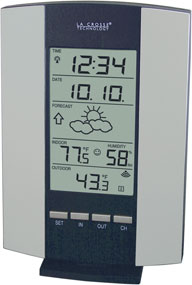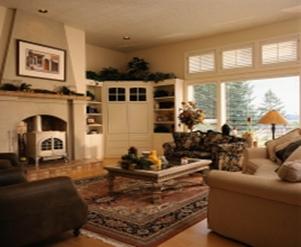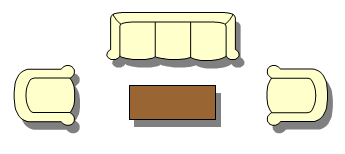![j0347225[1]](FCSFLIU09Setting_Home_image003.png)
SETTING
UP YOUR HOME
Unit Overview
Family members will feel good if they live in a comfortable home with space for their activities and needs. Knowing how to design this space will give them a sense of accomplishment.
|
Key Terms |
||
|
Accidents - Falls, electric shocks, cuts, and burns |
Decorating - choosing styles and adding personal touches to a home |
Empty nest – a stage in the family life cycle when all of the children have left home. |
|
Expanding family – a stage in the family life cycle when children are added to a family. |
Family Life Cycle – different stages of life |
Furnishing – obtaining furniture |
|
Launching stage – a stage in the family life cycle when children start to leave home |
Pollutant - a poisonous substance that can cause you to get sick |
Private Zone - where families sleep, bathe, and dress |
|
Social zone - where families visit with family members and friends |
Work zone – where families prepare meals, do laundry, and make repairs |
|
Your
Home
Homes provide much more than just shelter. They help meet basic needs of family members, including physical needs, safety needs, functional needs, personal needs and social needs.
|
Housing
Needs |
Homes
provide a place to: |
Example |
|
Physical Needs |
|
Monica likes to sit in front of her fireplace and keep warm during a snow storm. |
|
Safety Needs |
|
Since his home has several fire detectors, Patrick feels safe. |
|
Functional Needs |
|
Melvin appreciates the fact that he has a place to do his laundry and plenty of room to store his things in his new apartment. |
|
Personal Needs |
|
Monique has a place in her home to work on her scrapbooking. She likes to be able to go to her bedroom when she needs to be alone. |
|
Social Needs |
|
Cory likes to have his friends over to shoot hoops and watch movies. |
Family members need personal space where they can keep their own things and just be by themselves. They also need places to relax and interact with friends and other family members. Family members need areas where they can enjoy hobbies and leisure activities. The home environment provides a sense of security and belonging and influences the mental and emotional health of each family member. Homes also provide intellectual encouragement for family members. Functional needs are met through storage space and areas to complete everyday activities such as eating, sleeping, and socializing.
Individual and family growth is improved when time can be spent alone, in social interaction with others, and in learning opportunities at home. Children’s development is especially affected by the physical care, the learning opportunities offered, and the social situations they experience at home. Homes provide places for family members to grow and develop.
Housing
Needs and the Family Life Cycle
![j0426559[1]](FCSFLIU09Setting_Home_image007.jpg) Everyone goes through different stages in
their life, for example childhood, teenage years, young adult, marriage, having
children, children leaving home and retirement.
These stages are called the family
life cycle. Not everyone goes
through all of the stages. Not everyone
gets married or has children, for example.
As a family moves through the different stages, their housing needs
change. For example, a family with
several children would need more space than one that does not have
children. A single person who travels a
lot for work would need a home with little maintenance.
Everyone goes through different stages in
their life, for example childhood, teenage years, young adult, marriage, having
children, children leaving home and retirement.
These stages are called the family
life cycle. Not everyone goes
through all of the stages. Not everyone
gets married or has children, for example.
As a family moves through the different stages, their housing needs
change. For example, a family with
several children would need more space than one that does not have
children. A single person who travels a
lot for work would need a home with little maintenance.
E. Clark and S. Mirely identified 9 stages of the Family Life Cycle. The stages include living:
- as a -Single person
- with roommates-Unrelated adults
- with a spouse-Couple
- with small children-Expanding Family
- with children leaving the home-Launching stage
- with children without a spouse-Single-parent family
- without children – all have left home-Empty nest
- as an older couple-Active retirement
- as an older person with health issues-Restricted retirement
The single-person stage starts when persons move out of their family home and lasts until/or if they marry. This stage usually starts around the age of 18 and, for many people, lasts for 10 to 12 years. The single-person often lives in an apartment. Most people in this stage have very little furniture, so a one-room or one-bedroom apartment is big enough for their needs. Persons who remain single and live alone for several years acquire more belongings and will possibly need a bigger area. They may also have more income and may choose to buy a condominium, cooperative, or a single-family home. Their space needs often include a guest bedroom, a well-equipped kitchen, living and dining areas large enough to entertain friends and family, and storage space for hobbies, clothes, and sports equipment.
The number of unrelated adults living together has increased over the last several years. An example of this is a child’s going off to college and sharing a dorm room or apartment with one or more other students (roommates). Young adults, who share living areas, usually rent because it is less expensive and easier to relocate when they look for other schooling or jobs. Older adults often buy single family homes. Their needs at this stage include a private place to sleep, an area to study, a place to pursue hobbies, and store recreational equipment.
The couple stage occurs after marriage. Needs at this stage are very similar to those in the single-person stage. Because mobility, or being able to relocate, is often a high priority, apartments or small homes are a good choice during this stage.
![j0409148[1]](FCSFLIU09Setting_Home_image009.png) The expanding
stage begins when the couple’s first child is born. With this addition to
the family, space needs increase. Housing areas that are helpful include more
bedrooms, additional bathrooms, more storage area, extra laundry area, and
space for children to play both indoors and outdoors. Buying a home gives the
couple security and flexibility because it allows them to make changes or
additions to the home to meet the needs of their increasing family.
The expanding
stage begins when the couple’s first child is born. With this addition to
the family, space needs increase. Housing areas that are helpful include more
bedrooms, additional bathrooms, more storage area, extra laundry area, and
space for children to play both indoors and outdoors. Buying a home gives the
couple security and flexibility because it allows them to make changes or
additions to the home to meet the needs of their increasing family.
As children reach and go through adolescence, families enter the launching stage. Having enough space for family members to interact with friends and participate in a wide variety of activities is important now. There is a need for privacy for each family member and enough storage area for each person’s belongings. Families often move to larger homes or make additions to their existing homes during this stage. During this stage, children begin to leave home to live on their own.
Single-parent families are created when one parent dies, there is a divorce or separation, or when an adult has a child alone, whether naturally or through adoption. Single-parent families require basically the same housing needs as two-parent families, except they often do not have as much income to put toward housing costs. This often makes it impossible to purchase a home and, therefore, renting may be more reasonable.
As the last child leaves home, the couple enters the empty nest stage. The couple is generally still employed and often remains in the family home although their housing needs are decreasing. The larger home is often helpful as children and grandchildren come home for holidays. The family home frequently serves as storage space for childhood and college mementos.
![j0401993[1]](FCSFLIU09Setting_Home_image011.jpg) The active
retirement stage begins when the couple retires. These adults are often in good health and can
live independently. They often travel and do volunteer work. Visits from
grandchildren, hobbies, and social activities are important during this phase.
Less space is needed, but some adults prefer to stay in the family home. Others
choose to move into smaller homes or apartments that require less upkeep.
Another possibility is to rent out an unused part of the home to give them
additional income and less house to maintain. Living in ranch style homes with
one floor and wide doors to accommodate wheel chairs make it possible for
couples to stay in their homes for longer periods of time.
The active
retirement stage begins when the couple retires. These adults are often in good health and can
live independently. They often travel and do volunteer work. Visits from
grandchildren, hobbies, and social activities are important during this phase.
Less space is needed, but some adults prefer to stay in the family home. Others
choose to move into smaller homes or apartments that require less upkeep.
Another possibility is to rent out an unused part of the home to give them
additional income and less house to maintain. Living in ranch style homes with
one floor and wide doors to accommodate wheel chairs make it possible for
couples to stay in their homes for longer periods of time.
![j0398093[1]](FCSFLIU09Setting_Home_image013.png)
Increasing health problems move families into the restricted retirement stage. The members are less able to take care of themselves. If they are capable of staying in their homes, they may need someone to come in to help them with housework and home maintenance. Their income is usually limited, and health problems are taking a larger portion of their income. Different housing arrangements, such as nursing homes and continuing-care retirement communities are helpful.
Home
Safety
No matter what stage a family is in, safety is very important to promote the well-being of everyone. Approximately one-third (1/3) of all accidents occur at home. Of these accidents in the home, about seventy percent (70%) are due to carelessness. Falls, electric shocks, and burns are the most frequent. Accidents can be prevented by:
- slowing down and thinking about what you are doing
- thinking about what might cause an accident
- working with power tools, ladders and other equipment only when rested
- repairing or replacing home equipment when needed.
Smoke detectors alert people to a possible fire. Families need to be prepared for such emergencies. For each room in your home, plan at least two escape routes where you can exit in case there is a fire. It may be necessary to purchase an escape ladder for upper-story bedrooms. Choose a meeting place away from the house so all family members can report in. That way you will know everyone has gotten out. Occasionally, practice the route so you will know what to do if there is a fire in your home.
You should have at least one smoke detector on each floor of your home. If at all possible, have a smoke detector in every room of your home, except for the bathroom and kitchen. Steam in the bathroom sometimes triggers the smoke detector, as do cooking fumes in the kitchen. Keep a fire extinguisher on each floor of your home. Make sure family members know how to operate it.
Air quality inside the home is very important. Problems may arise because air inside the home is 100 times more concentrated than outside. Keeping air quality dangers low can be accomplished by bringing fresh air in through windows, air exchangers, and clean air vents.
Security is another important consideration. Keeping doors and windows locked when no one is home will help prevent break-ins. Lights by entrance doors allow family members to see who has come for a visit and help them see the keyhole to unlock the door when they return home.

Wireless Weather Station
Weather-Related
Emergencies
Weather-related emergencies include tornadoes, hurricanes, snowstorms, blizzards, floods, hailstorms, and earthquakes. You should be prepared for these emergencies. Many communities have warning systems to alert you to severe storms or strong winds. The National Weather Service also issues advisories for severe weather. Advisories are either “watches” or “warnings.” For instance, hurricane or tornado watches mean there is a possibility a hurricane or tornado. Warnings mean it has been sighted. Warnings are often accompanied by safety instructions.
In the case of hurricanes, secure your home by boarding up windows and doors. Evacuate to a safe location. The farther inland you go, the safer you should be.
If a tornado is on the way, go to the basement or storm cellar. If this is not possible, stay in a hallway, closet, or bathtub. If you are outside, lie face down in a ditch.
If you are indoors when you feel tremors of an earthquake, stay inside. Try to find a safe spot, an area that provides some protection from falling objects. If you are outside when the earthquake starts, stay away from power lines, trees, and buildings that might fall.
A blizzard is a snowstorm with winds blowing 35 mile an hour or stronger. The safest place is inside. If you must be outdoors, dress in layers, keep moving, and keep your nose and mouth covered as much as possible.
Home
Pollutants
A pollutant is a poisonous substance that can create problems in your home and may cause you to get sick. If there is a pollutant in your house, you may not notice anything at first. Over time, pollutants can cause serious health problems. The majority of indoor pollutants are in the air. The age of your home, where it is located, and the products used in your home determine what pollutants are in your home.
Carbon monoxide is an invisible gas caused by heating equipment that is not vented properly. It is not getting enough air. Check your furnace and any other heating units regularly to be sure they are working properly and are well vented. A carbon monoxide detector in your home will alert you if there is a problem.
Radon, a colorless, odorless, radioactive gas, can get into your home through cracks in the basement floor or walls. A high level of radon increases your chances of having lung cancer. Test kits are available to check the levels in your home. If the levels are high, call your doctor and a building contractor for advice on correcting the problem.
Asbestos, a building insulation used prior to 1978, has tiny fibers. Inhaling these fibers can cause lung cancer. You need a professional to remove or seal off the asbestos.
Lead can come from flaking paint, antique pottery, lead pipes, or solder. If lead enters your body, it can cause developmental and behavioral problems.
|
|
|
|
|
|
|
Living Room |
Bedroom |
Kitchen |
Utility Room |
Family Room |
Areas
of a Home
A home can be divided into three major areas or zones based on the activities that occur in those areas.
Social Zone: The social zone is where the families visit friends, have meetings and parties, and where children play. Hobbies, music, games, watching television, reading, sewing, studying, and conservation are activities that take place in this area of homes. Some of the rooms in the social zone are living room, dining room, family room, recreation room, and game room
Private Zone: Bedrooms and bathrooms are in this area. Activities include sleeping, bathing, and dressing.
Work Zone: The main work areas in a home are the kitchen and the laundry. Work in these areas may involve one or more people.
Some activities, such as listening to music or playing games, may be noisy. A buffer area between zones helps block out sound, view, or both. For instance, closets along the bedroom wall help block sounds from the family room.
Sharing
Living Space
The easiest way for families to share living space is to have enough space so all activities of all family members can take place in their home. Areas used for two or three purposes can create conflict among family members. For example, if Jonathan, the 20 year old college student, uses the family room couch as his bed when he is home for the summer, there could be a problem. Jonathan likes to sleep until noon. His mom and dad get up for work at 5:45 a.m. They like to sit in the family room, drink a cup of coffee, and read the morning paper before they set out for work. They need the lights on, and Jonathan is not very happy about the disturbance.
![bd07580_[1]](FCSFLIU09Setting_Home_image026.png)
Furnishing
a Home
Once a family has chosen where to live, they have to make decisions about furniture and accessories. This process usually takes time. Following these steps may make the process easier.
- Make a list of the activities that will take place in the area. Prioritize the list; for instance, when choosing furnishings for a bedroom, a bed for sleeping is a priority while a desk for doing homework may not be as important. School work could be completed at the kitchen table.
- Look at the physical size and shape of the room and consider the traffic patterns. Traffic patterns are how people move around the room or from room to room. For example, when you come into your bedroom with clothes to hang in the closet, what path do you follow? How do you move around in the room when you put away folded clothes? Placing a table in the middle of one of these paths makes it inconvenient to move around it. Think about the placement of doors and windows. Can you place furniture in front of windows without blocking the sunlight? Will sunlight damage the furniture? When furniture is placed by a door, is there enough room to completely open the door?
- List the furniture you need for each area. What do you have and what additional furniture is needed for the area? Come up with different furniture arrangements for the area.
Obtaining
Furniture
![j0400307[1]](FCSFLIU09Setting_Home_image028.jpg) Buying new furniture is fun if you have
money to do so, but if you don’t, there are places to get furniture at lower
costs.
Buying new furniture is fun if you have
money to do so, but if you don’t, there are places to get furniture at lower
costs.
- Family members or friends may offer pieces of furniture they no longer need or aren’t using at the moment.
- You may be able to find nice used furniture at flea markets or garage sales.
- Thrift shops such as those operated by the Salvation Army or Goodwill Industries have used furniture at lower prices than if they were new.
- You may rent furniture rather than purchase your own.
- Unfinished furniture is less expensive than finished furniture. This is wood furniture that has not had varnish or finishing coats applied. Instructions and supplies for finishing furniture are usually available at the same location as the furniture. You can also find helpful hints online.
- Buying new furniture is also an option. Be selective. Do not buy it unless it is really what you want.
Other factors also influence your room or home arrangement.
v Personal tastes of family members are one factor. Are they very formal or more casual or country?
v Values important to the family will affect how they arrange their home. If they value education, the family will be certain there is space for children to complete homework.
v Hobbies of family members will affect the space they need. Family members who enjoy music have different needs than someone who builds radio control airplanes.
v Furniture the family already has and the money they have available to make additional purchases affect decisions.
v Families who own homes will be more likely to spend money on additional items. Families that rent may move to new locations in a couple years. Furniture purchased now may not fit into future homes.
v Family size and the amount of space they have will also influence decisions made about furniture and accessories.

Home Decorating
Furnishing your home is obtaining the furniture necessary for your lifestyle. Decorating is choosing styles and adding a personal touch that makes your home special.
Color is important to how a room looks and feels. Painting walls can make rooms appear clean or livelier and may create a feeling of rest or contentment. Bright, intense colors seem to advance and will make rooms appear smaller. Soft, unimposing colors tend to recede or make rooms appear larger. Paint is usually less expensive than wallpaper.

Create a center of interest or focal point for each room. This will grab the attention of persons entering the area. For instance, the focus may be a fireplace or a window. In the picture above, the fireplace and picture above it are the center of interest. The furniture is arranged so your attention is drawn to the fireplace and picture.
Use furniture to create different areas within your room. A desk and chair in the corner will create a small office spot. The television, couch, and chairs grouped on the opposite wall will create a social or recreation area.
Other decorating tips include:
- Select furniture that is similar in size, weight, and proportion.
- Position lights so they light the area.
- Using mirrors helps to make a room brighter. They reflect the light and also make a room look larger.
- When arranging mirrors or pictures on a wall, uneven numbers are more pleasing to the eye than even numbers. Rather than using two pictures, use three pictures on your wall.

Furniture Arrangements
- Avoid lining all the furniture around the walls of the room. Placing the sofa and chair closer together makes the area look more inviting and makes it easier to talk with one another.

- Avoid putting items in the way of people trying to watch television or talk with others in the room.
- Avoid blocking traffic patterns
- First place large pieces of furniture. Smaller pieces of furniture are easier to place around the large pieces.
Be
It Ever So Humble ... There's
No Place Like Home!
 |
| Unit 9 Setting Up Your Home (Puzzle) Worksheet |
| Unit 9 Setting Up Your Home (Advance Organizer) Worksheet |
![j0430534[1]](FCSFLIU09Setting_Home_image016.jpg)
![j0430537[1]](FCSFLIU09Setting_Home_image018.jpg)
![j0399688[1]](FCSFLIU09Setting_Home_image020.jpg)
![j0426548[1]](FCSFLIU09Setting_Home_image022.jpg)
![j0414059[1]](FCSFLIU09Setting_Home_image024.jpg)